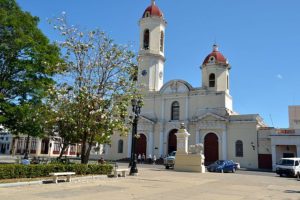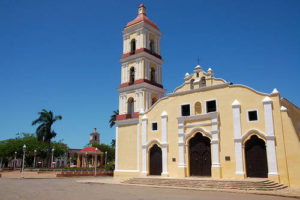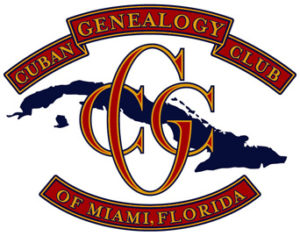Ecclesiastical Records
Santa Clara/Las Villas Province
About Santa Clara/Las Villas Churches Collection
As of March 2023, we have 2 churches represented.
IMPORTANT: These files are for personal use only! The use of the information on this site for commercial, political, or any other purpose other than research of your family history and genealogy is strictly forbidden.
Please contact, and credit, the CGC prior to using any part of this collection by sending an email to secretary@cubangenclub.org.
About the Province
Santa Clara was known as Las Villas after 1940. It is a historical province of Cuba. After 1976, its territory was divided into the modern Cuban provinces of Villa Clara, Cienfuegos, and Sancti Spíritus.
Cuban Church Records and Archives
A presentation on Cuban Church Records and Archives given by Fr. Juan Luis Sanchez on July 14, 2008 is offered here for dissemination with his permission.
A recording of this presentation is available for members on the Members Only-Videos Page
Alphabetical Index Supplement for the Provinces of Habana, Las Villas and Pinar del Rio, Cuba
Source: REVISTA (the quarterly publication of the Cuban Genealogical Society)
An alphabetical index of all the transcriptions from the various parishes of La Habana, Guanabacoa, Cienfuegos, Las Villas, and San Matias de Rio Blanco in Pinar del Rio that was published in REVISTA from 2000 to 2007. This index supplements the previous indices for the provinces of Habana and Las Villas that were published in 1995. In addition, it has the Province of Pinar del Rio, which did not have an index published previously. The first few pages explain how to read the entries in the index.
All of the REVISTA editions are available on CubaGenWeb.
British Library's Endangered Archives Programme
Other
Resources
Slave Societies Digital Archive at Vanderbilt University
The Slave Societies Digital Archive (SSDA), directed by Jane Landers at Vanderbilt University, was launched in 2003. It is dedicated to identifying, cataloging, and digitally preserving endangered archival materials documenting the history of Africans and their descendants in the Atlantic World.
Slave Societies teams digitally captured ecclesiastical records of more than 750,000 individuals during almost three years of intensive work in Cuba and Brazil. Beginning in 2007, another grant allowed the group to preserve additional records at new project locations in Brazil, Colombia, and Cuba.

La Purísima Concepción Cathedral in Cienfuegos, Cuba
The church is currently located at Ave. 56 #2902 between 29 and 31 in the city of Cienfuegos, province of Cienfuegos.
Church Documents on SSDA
Libro 1 de Bautismos de Pardos y Morenos (1819 – 1835)
Libro 2 de Bautismos de Pardos y Morenos (1835 – 1839)
Libro 3 de Bautismos de Pardos y Morenos (1839 – 1843)
Libro 6 de Bautismos de Pardos y Morenos (1850 – 1855)
Libro 7 de Bautismos de Pardos y Morenos (1855 – 1860)
Libro 8 de Bautismos de Pardos y Morenos (1860 – 1863)
Libro 10 de Bautismos de Pardos y Morenos (1867 – 1871)
Libro 11 de Bautismos de Pardos y Morenos (1871 – 1873)
Libro 12 de Baustismos de Pardos y Morenos (1873 – 1876)
Libro 7 de Matrimonios de Blancos (1894-1908)
Alphabetical Index of the Parish Registers of Las Villas, Cuba by the Cuban Genealogical Society*
This alphabetical index includes all the transcription from the Cathedral of the city of Santa Clara, and the city of Remedios. This index includes all the transcriptions available for the province of Oriente, which were made by Francisco Xavier de Santa Cruz and his associates.
The transcriptions were published in a number of issues of REVISTA, the quarterly publication of the Cuban Genealogical Society, since 1988. The information contained in the following index has the same format as the listings published, with the exception of the source number, to which it has been added the number of the REVISTA where it appeared first.
The format consists of the following information:
First column is Surmame; Second column is Name; Third column is Sex; Fourth column is Date of the event or ceremony; Fifth column is Type of event: M=marriage, B=baptism, D=death, C=confirmation,
G=related to the person performing the ceremony, usually a parent or previous spouse, or a witness to the ceremony; Sixth is the Source Number which consists of the following codes: 6 digits of source; (,) 5 digits of book and page or page only; (#) entry number; (R) REVÍSTA volume and issue number.
When finding a name that you are interested in, make note of the Source Number, date, and parish, then refer to the REVISTA issue that has the entry published with all the members of the families in question together as an entry. This process will give you the names of all the persons involved in the ceremony.
Note:
The surnames and given names have been kept in the form that appeared in the original transcription, even though it was sometimes obvious that the spelling was not the one used in modern times.
In order to find a surname that you are interested in, please consider and check all the possible spellings for that name. For Example: Jiménez and Ximenez; Avalo and Abalo, etc.
*The Cuban Genealogical Society is now defunct. We are grateful to Mayra Sanchez-Johnson for her work.

San Juan Bautista de Remedios Church in Remedios, Cuba
The Parish Church of San Juan Bautista, located in the heart of Remedios, is composed of the main church, Parroquial Mayor de San Juan Bautista, and a chapel known as Ermita del Buenviaje. The two religious structures are magnificent examples of Spanish colonial architecture in the Caribbean. The history of the main church dates to the late sixteenth century, but the current architectural core was constructed in the first half of the eighteenth century in a Moorish Renaissance style with baroque features. It is renowned for its polychrome coffered ceiling and gilded altar. The neoclassical bell tower was added in 1850, and a second level to the sacristy in the early 1900s. Ermita del Buenviaje is a single-nave neoclassical chapel with a bell tower, but reflects Moorish and Spanish influences. A chapel occupied the site as early as the sixteenth century, though the current design dates to 1819 and was rebuilt in 1867 after a fire.
The main church was declared a National Monument in 1949, and the same designation was extended to the entire town of Remedios in 1980. The church is located at Plaza Isabel II Remedios, Cuba.
The following file was transcribed and given to the Cuban Genealogy Club of Miami, Fl., Inc. (CGC) by Hilda Pomares Treto. Her sources are Dr. Jose Antonio Mahy and the unpublished papers of Francisco Xavier de Santa Cruz y Mallen, Conde de San Juan de Jaruco. We thank Hilda for her hard work and generosity!
Book 1 (May 1640 to 17 Feb 1700) and Book 2 (9 Jan 1701 to 11 Sept 1751)
Maria Manso y Campos (1655)
Juan Perez y Marquez (no date)
Nicolas Manso de Contreras y de Campos (1671)
Nicolas de Loyola Diaz Anna de Loyola Diaz
Nicolas Espinosa y Nuñez (1672)
Maria Hernandez de Medina y Vidal (1673) Catalina de Soria y Manso de Contreras (1679)
Juan de Loyola Diaz (1685)
PDF File for 1700 – 1749 containing the names below
Joseph Manso y Hernandez (1702)
Eulalio Mario Perez y Hernandez (1704)
Manuela Fernandez Vidal y Perez de Prados (1712)
Andres Mansso y Hernandez (1713)
Joseph Perez y Loyola (1715)
Andrea Guevara y Hernandez (1716)
Pablo Perez y Hernandez Vidal (1717)
Isabel Hernandez Vidal y Perez (1717)
Gabriela del Rio Loyola (1718)
Juan Perez de Loyola (1719)
Manuela Hernandez de Medina y Perez de Prado (1725)
Balthasar Espinosa y Chagaray (1720)
Josefa Manuela Loyola Monteagudo (1720)
Beatris de Loyola Monteagudo (1725)
Miguel de Loyola Monteagudo (1726)
Isabel Hernandez Medina y Peres (1730)
Joseph Francisco T. Loyola Monteagudo (1737)
Maria Manzo de Contreras de Guevara (1737)
Joseph Manso de Contreras y Perez de Prado (1738)
Andres Manso de Contreras (1739)
Josef Maria Peres de Prados y Rio (1739)
Isabel de Jesus Manso de Contreras y de Loyolas (1739)
Maria de los Dolores Manso de Contreras y de Loyolas (1741)
Rafael Manso de Contreras y Perez de Prado (1741)
Juan Francisco Xavier Peres de Prados y Rio (1741)
Juan Antonio del Portal Llanes (1741)
Manuela de San Martin Mansso de Contreras y de Loyola (1742)
Isabel Maria Peres de Prados y del Rio (1743)
Rosa Gabriela Manso y Perez (1744)
Raphael Antonio Peres de Prados y Rio (1744)
Lucas Peres y Loyola (1745)
Theresa de Jesus Alarcon y Portal (1745)
Maria de la Encarnacion Peres de Prados y del Rio (1746)
Maria de Jesus Manso de Contreras y Perez de Prado (1746)
Joseph Manuel Peres de Prado y Rios (1747)
PDF File for 1750-1799 containing the names below
Maria de Jesus Peres de Prados y Rio (1750)
Jose Manuel de la Trinidad de Loyola Ximenez (1756)
Josefa Maria Comas Delgado (1759)
Miguel Loyola Monteagudo (1762)
Juan Bautista de Loyola y Gonzalez (1769)
Teresa de Jesus Dorotea del Portal y Alarcon (1780)
Juan Francisco Espinosa Chagaray (1780)
Raphael de Jesus Pelicarpo Crespo y Diaz (1781)
Maria Manuela Peres y Guijarro (1781)
Jose Manuel Peres de Prado y Comas (1786)
Josefa Maria Peres de Prado y Comas (1787)
Policarpo Peres de Prados y Coma (1789)
Rita Peres de Prado y Comas (1790)
Ana Josefa Joaquina Peres de Prado y Comas (1792)
Jose Miguel Peres de Prados y Comas (1796)
Juan Baptiste de Loyola y Gonzalez de Rojas (1796)
Gabriela Josefa de Jesus Peres y Comas (1798)
Manuela Josefa Peres de Prado y Comas (1799)
PDF File containing the names below
Isabel Josefa Peres de Prados y Comas (1801)
Jose Maria de Jesus Loyola Espinosa (1804)
Alejos de la Cruz Loyola Espinosa (1807)
Jose Manuel Perez y Perez (1823)
Miguel Mariano Perez de Prados y Perez de Alejos (1824)
Isabel Maria Loyola y Gonzalez (1824)
Luis Francisco Perez y Perez (1825)
Micaela Antonia Evarista Perez Perez (1827)
Josefa Maria Perez y Perez (1829)
Rafael Antonio Crespo Rodriguez (1830)
Jesus Maria Perez y Perez (1833)
Maria Felix Peres Peres (1837)
Maria Magdalena Estorino y Alcantara (1841)
Josefa del Buenviage Hernandez Espinosa (1848)
Antonia Josefa Anselma Romero de Loyola (1851)
Maria del Rosario de Loyola (1856)
Feliciana de la Caridad Crespo Torrecillo (1863)
Joaquin Mariano de Jesus Perez Vazquez (1865)
Angel de Jesus Maria Treto Estorino (1873)
Basilisa Anastasia de la Candelaria Sobrado Hernandez (1876)
Prudencio Fallada Loyola (1880)
Buenviaje Adriana Rodriguez Crespo (1889)
PDF file containing the names below
Salvador Hernandez de Medina / Maria Vidal Perez (1660)
Sebastian Perez y Perez de Prado / Sebastiana Rodriguez y Marquez (1660)
Juan Manuel de Guevara Loyola / Andrea Rojas y Campos
Francisco Espinosa / Maria Manso
Felis de Espinosa / Maria de los Reyes Nuñez (1678)
Leonardo Perez y Rodriguez / Andrea Hernandez de Medina y Vidal (1698)
Antonio Hernandez de Medina / Maria del Castillo (1698)
PDF file for 1700 to 1749 containing the names below
Francisco Echagaray Leturiondo / Maria Concepcion Sancedo (1700)
Bartholome Mansso y de Campos / Isabel Hernandez de Medina y Vidal (1701)
Andres Rodriguez y Hernandez / Bonifacia Guijarro y Soria (1707)
Juan Perez / Cathalina de Soria (1707)
Nicolas Manso de Campos / Lucia Ana de Loyola Perez (1712)
Jacinto de Guevara / Josefa Hernandez y Perez (1712)
Antonio del Rio / Francisca Loyola (1713)
Juan de Loyola Diaz / Josepha de Monteagudo (1718)
Nicolas de Espinosa / Lucia Chagarai (1720)
Cristobal de Roxas / Maria Magdalena Hernandez de Medina (1731)
Joseph Peres de Alejos / Isabel Hernandez de Medina (1733)
Juan Perez de Prado / Monica de Monteagudo (1733)
Andres Manso de Contreras y Hernandez de Medina / Andrea de Guevara Ledesma y Hernandez (1733)
Joseph Manso de Contreras / Maria Eulalia Perez de Prado (1735)
Juan Perez de Prados / Gabriela del Rio (1738)
Bartholome Manso de Contreras y Hernandez Medina / Josepha de Loyola y de Monteagudo (1739)
Pablo Peres de Prado / Beatris de Loyola (1741)
Andres de Alarcon / Candida del Portal (1742)
Miguel de Loyola Monteagudo / Isavel Ximenez (1747)
Bernabe Antonio de Alcantara / Anna Rodriguez (1748)
PDF file for 1750 to 1799 containing the names below
Juan Perez de Alejos / Manuela Hernandez (1751)
Juan Joseph de Espinosa / Josepha Perez de Prado (1759)
Joseph Francisco de Loyola de Monteagudo / Antonia Josepha Gonzalez de Roxas y Hernandez del Portal (1761)
Bernabe Fernandez / Gertrudis de Roxas (1764)
Lucas Peres de Prado / Josepha Guijarro (1773)
Juan Antonio del Portal y Llanes / Theresa Alarcon Portal (1775)
Josef Manuel de Loyola Ximenez / Maria de Espinosa Perez de Prado (1781)
Manuel Peres de Prado / Josefa Maria de los Angeles Comas (1785)
Manuel de Alcantara / Maria Manuela Peres Guijarro (1797)
PDF file containing the names below
Juan Francisco Espinosa / Theresa de Jesus del Portal (1804)
Juan Baptista de Loyola / Maria Rosalia Cabrera (1818)
Policarpo Perez de Prado / Maria Clara Susana Perez de Aelxos (1822)
Mariano Perfecto Estorino / Maria del Carmen Alcantara (1825)
Manuel Jose Alcantara / Antonia Josefa de Roxas (1826)
Rafael de Jesus Crespo / Maria de los Dolores Rodriguez (1829)
Jose Maria de Loyola Espinosa / Josefa Antonia Ximenez Muxica (1831)
Jose Manuel Tedecilla / Antonia Maria Quintanilla (1838)
Jose Antonio Hernandez / Maria del Buenviage Espinosa (1846)
Jose Francisco Ladislao Romero / Isabel de Loyola (1849)
Manuel Joaquin Moreno / Francisca de Paula Alcantara (1850)
Rafael Antonio Crespo / Isabel Maria Torrecillos (1862)
Miguel Mariano Perez Perez / Antonia Vazquez Pino (1862)
Francisco Fallada y Dalco / Maria del Rosario Loyola y Loyola (1878)
Alphabetical Index of the Parish Registers of Las Villas, Cuba by the Cuban Genealogical Society*
This alphabetical index includes all the transcription from the Cathedral of the city of Santa Clara, and the city of Remedios. This index includes all the transcriptions available for the province of Oriente, which were made by Francisco Xavier de Santa Cruz and his associates.
The transcriptions were published in a number of issues of REVISTA, the quarterly publication of the Cuban Genealogical Society, since 1988. The information contained in the following index has the same format as the listings published, with the exception of the source number, to which it has been added the number of the REVISTA where it appeared first.
The format consists of the following information:
First column is Surmame; Second column is Name; Third column is Sex; Fourth column is Date of the event or ceremony; Fifth column is Type of event: M=marriage, B=baptism, D=death, C=confirmation,
G=related to the person performing the ceremony, usually a parent or previous spouse, or a witness to the ceremony; Sixth is the Source Number which consists of the following codes: 6 digits of source; (,) 5 digits of book and page or page only; (#) entry number; (R) REVÍSTA volume and issue number.
When finding a name that you are interested in, make note of the Source Number, date, and parish, then refer to the REVISTA issue that has the entry published with all the members of the families in question together as an entry. This process will give you the names of all the persons involved in the ceremony.
Note:
The surnames and given names have been kept in the form that appeared in the original transcription, even though it was sometimes obvious that the spelling was not the one used in modern times.
In order to find a surname that you are interested in, please consider and check all the possible spellings for that name. For Example: Jiménez and Ximenez; Avalo and Abalo, etc.
*The Cuban Genealogical Society is now defunct. We are grateful to Mayra Sanchez-Johnson for her work.
